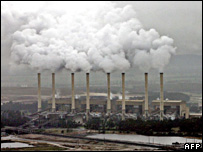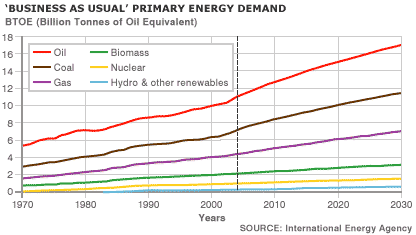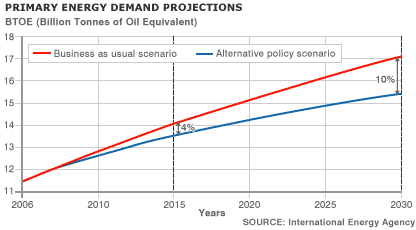Our Energy Future: 'dirty, insecure and expensive'
 London, UK (BBC) - The world could be dependent on “dirty, insecure and expensive” energy by 2030, an influential report has warned.
London, UK (BBC) - The world could be dependent on “dirty, insecure and expensive” energy by 2030, an influential report has warned.Current trends showed that demand for power was set to grow by 53% by 2030, the International Energy Agency said. But if governments deliver on promises to push cleaner and more efficient supplies, growth in demand could be restrained by about 10%, it suggests. Greater use of nuclear power could be a “valuable option” to cut imports and curb CO2 emissions, the study added.
The International Energy Agency’s (IEA) World Energy Outlook (WEO) 2006 also echoed the findings of a recent UK report that said the benefits of cutting emissions outweighed the costs of combatting climate change.
“WEO 2006 reveals that the energy future we are facing today, based on projections of current trends, is dirty, insecure and expensive,” said Claude Mandil, executive director of the IEA. “But it also shows how new government policies can create an alternative energy future which is clean, clever and competitive,” he added. The document considered two scenarios:
- Business as usual - Referred to in the report as the “reference scenario”, this projects how the globe’s energy mix would look in 2030 if current trends were followed
- Alternative policy scenario - projects how the energy mix would appear in 2030 if the package of policies and measures being considered by governments were adopted
Overall, the WEO says primary energy demand would grow by about 53%, with fossil fuels accounting for 83% of the increase between 2004 and 2030. But it said that the alternative policy scenario projected that the growth in demand for energy could be cut by 10% by 2030 - the equivalent to China’s current total energy consumption.
It also said this scenario would deliver 16% less carbon dioxide (CO2) emissions than the business as usual scenario, the same as the current total emissions from the US and Canada combined.

Nuclear option
The WEO champions the role of nuclear power, saying it could make a “major contribution to reducing dependence on imported gas and curbing CO2 emissions”.
It forecasts that the total global generation capacity of nuclear power plants could increase from 368 gigawatts in 2005 to 519 gigawatts in 2030.
The additional nuclear power plants would also have the advantage of being less vulnerable to fuel price changes than coal or gas-fired generation, helping to enhance the security of electricity supplies. However, it said that governments would have to convince the private sector that the initial investment of about $2bn-3.5bn (£1-1.8bn) per reactor would be a wise move.
Ian Hore-Lacy, director of public communications for the World Nuclear Association, welcomed the IEA’s report. “Given that world energy demand, and more particularly electricity demand, is increasing strongly, we need sources of electricity supply that are safe, affordable, with abundant fuel and are environmental benign,” he said. “The virtues of nuclear power in all of those respects are becoming widely obvious.” But Greenpeace International called it a “wasted opportunity”.
In a statement, the environmental group said: “While it is important that the IEA has finally recognised the need to drastically change the global energy supply in light of climate change, it has offered ‘business as usual’ solutions, which are not commensurate with the problems it seeks to solve.”
They said the agency’s nuclear plan would require more than 200 new nuclear reactors in the next 24 years, which was “neither desirable nor realistic”.
Biofuels growth
The report also projected that biofuels were set to play an increasing role in road transport, providing up to 7% of the total consumption in 2030.
To meet this demand, the IEA envisaged that the total amount of arable land required would be equivalent to at least the combined size of France and Spain.
 But the WEO warned that the growing demand for food would limit the potential of the plant-derived fuel produced using current technologies. Yet the emergence of new “second generation” technologies, which allow more of a plant’s material to be turned into fuel, could allow biofuels to play a much bigger role in either of the projections outlined in the report’s two scenarios, it said.
But the WEO warned that the growing demand for food would limit the potential of the plant-derived fuel produced using current technologies. Yet the emergence of new “second generation” technologies, which allow more of a plant’s material to be turned into fuel, could allow biofuels to play a much bigger role in either of the projections outlined in the report’s two scenarios, it said.As for the financial viability of the alternative policy scenario, the IEA reached a similar conclusion to the findings outlined in a report by Sir Nicholas Stern, who was commissioned by the UK government to assess the economic impact of climate change.
“The good news is that these policies are very cost effective,” said Mr Mandil. “There are additional upfront costs involved, but they are quickly outweighed by savings in fuel expenditure.” He added that every $1 invested in energy efficient appliances and equipment delivered a $2 saving on power generation.
The report concluded that a shift to the alternative scenario would “serve all three of the principal goals of energy policy: greater security, more environmental protection and improved economic efficiency”.
To download a copy of this report please“click here”.


You can return to the main Market News page, or press the Back button on your browser.

